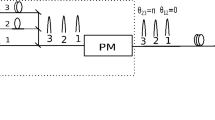Abstract
The quantum circuit and design are presented for an optimized entangling probe attacking the BB84 Protocol of quantum key distribution (QKD) and yielding maximum information to the probe. Probe photon polarization states become optimally entangled with the signal states on their way between the legitimate transmitter and receiver. Although standard von-Neumann projective measurements of the probe yield maximum information on the pre-privacy amplified key, if instead the probe measurements are performed with a certain positive operator valued measure (POVM), then the measurement results are unambiguous, at least some of the time. It follows that the BB84 (Bennett–Brassard 1984) protocol of quantum key distribution has a vulnerability similar to the well-known vulnerability of the B92 (Bennett 1992) protocol
Similar content being viewed by others
References
Bennett C.H. (1992). Phys. Rev. Lett. 68:3121–3124
Gisin N., Ribordy G., Tittel W., Zbinden H. (2002). Rev. Mod. Phys. 74:145–195 (See p. 152.)
Brandt H.E. (1999). Am. J. Phys. 67:434–439
Brandt H.E., US Patent No. 5,999,285 (7 December 1999)
Bennett C.H., Brassard G. (1984). In : Proceedings of the IEEE International Conference on Computers, Systems, and Signal Processing, Bangalore, India. IEEE, New York, pp. 175–179
H. E. Brandt, : SPIE Proc 5436:48–64 (2004). [In Eq. (132), sin μ and cosμ should be interchanged in the coefficient of |w 3 <] only. Also, e 2θ should be e θ. In Eq. (195), the overall sign of the coefficient of |w 2 < should be ∓
Slutsky B.A., Rao R., Sun P.C., Fainman Y. (1998). Phys. Rev. A 57:2383–2398
Fuchs C.A., Peres A. (1996). Phys. Rev. A 53:2038–2045
Brandt H.E. (2002). Phys. Rev. A 66(16):032303
Brandt H.E. (2002). J. Math. Phys. 43:4526–4530
Brandt H.E. (2003). J. Opt. B 5:S557–S560
Brandt H.E. (2003). Quantum Inform. Process 2:37–79
Brandt H.E. (2005). Phys. Rev. A 71(14):042312
Brandt H.E. (2005). to appear in : J. Mod. Opt
Brandt H.E.(2004). Invention Disclosure: Quantum Cryptographic Entangling Probe (U.S.) Army Research Laboratory, Adelphi, MD,
Brandt H.E. (2000). Phys. Rev. A 62(14):042310
Brandt H.E. (2001). Phys. Rev. A 64(5):042316
Brandt H.E. (2002). Contemporary Math 305: 43–52
Author information
Authors and Affiliations
Corresponding author
Additional information
Pacs: 03.67.Dd, 03.67.Hk, 03.65.Ta
Rights and permissions
About this article
Cite this article
Brandt, H.E. Unambiguous State Discrimination in Quantum Key Distribution. Quantum Inf Process 4, 387–398 (2005). https://doi.org/10.1007/s11128-005-0003-0
Received:
Accepted:
Published:
Issue Date:
DOI: https://doi.org/10.1007/s11128-005-0003-0




